基于非负矩阵分解的递归稀疏表示的心肺音分离方法
邹振城 刘厶元
基于非负矩阵分解的递归稀疏表示的心肺音分离方法
邹振城 刘厶元
(广东工业大学)
针对心肺音的时序结构特性,提出一种基于非负矩阵分解的递归稀疏表示的心肺音分离方法。通过非负矩阵分解构建能有效描述心肺音的递归特征心肺音字典;基于该字典,获得心音和肺音的稀疏表示,实现心肺音分离。实验结果表明:本文设计的心肺音分离方法取得的效果优于基于非负矩阵分解的稀疏表示的心肺音分离方法、监督非负矩阵分解方法的心肺音分离和带通滤波。
心肺音分离;非负矩阵分解;递归;稀疏表示
0 引言
据《World Health Statistics 2018: Monitoring health for the SDGs》报告[1],心血管疾病和呼吸道疾病的发病率呈逐年上升趋势。听诊是临床常用的心血管和呼吸道疾病的诊断方法,传统的心脏听诊依赖于医生的临床经验[2-3]。然而,通过听诊器采集到的心音和肺音常混叠在一起,影响听诊的有效性。因此,研究心肺音分离方法对提高听诊质量,协助医生进行辅助诊断具有重要的现实意义。临床采集的混合信号中,心音和肺音在60 Hz~320 Hz频带存在相互干扰。传统的带通滤波[4]仅适用于分离频带相互分离的源成分,无法有效地将心音和肺音完全区分开;自适应滤波方法[5]和小波变换方法[6]性能依赖精确模板和参数选择,难以实际推广。
非负矩阵分解(non-negative matrix factorization,NMF)是一种常用盲分离方法[7],通过抽取随时间变化的心肺音幅模,能捕捉变换域重复出现的模式,适于心肺音分离。然而,基于监督NMF的心肺音分离方法[8]忽略了肺音频域模式复杂多样的特点,分离效果欠佳。基于字典学习的稀疏表示的单通道盲分离方法克服了以上的不足,并已广泛用于信号处理,如无线通讯[9-10]和生物医学[11]等领域。但是,以上方法都忽略了心肺音信号时序上的递归特性。
本文在基于NMF的稀疏表示的心肺音方法上进行改进,提出基于NMF的递归稀疏表示的心肺音分离方法,实现心肺音分离,从而提高心肺音分离的信噪比。
1 心肺音混合模型
临床采集到心肺音混合信号可用式(1)线性混合模型表示[8]:

通过小波变换方法[12]滤除白噪声后,可认为心肺音混合信号只含有心音和肺音,其数学模型为

2 非负矩阵分解



利用梯度下降法可得到:
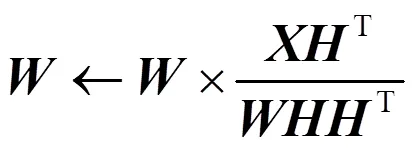
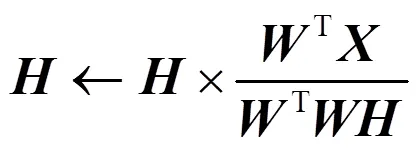
3 基于非负矩阵分解的递归稀疏表示
3.1 递归字典构建
基于非负矩阵分解的递归稀疏表示的心肺音分离方法的构造字典示意图如图1所示。
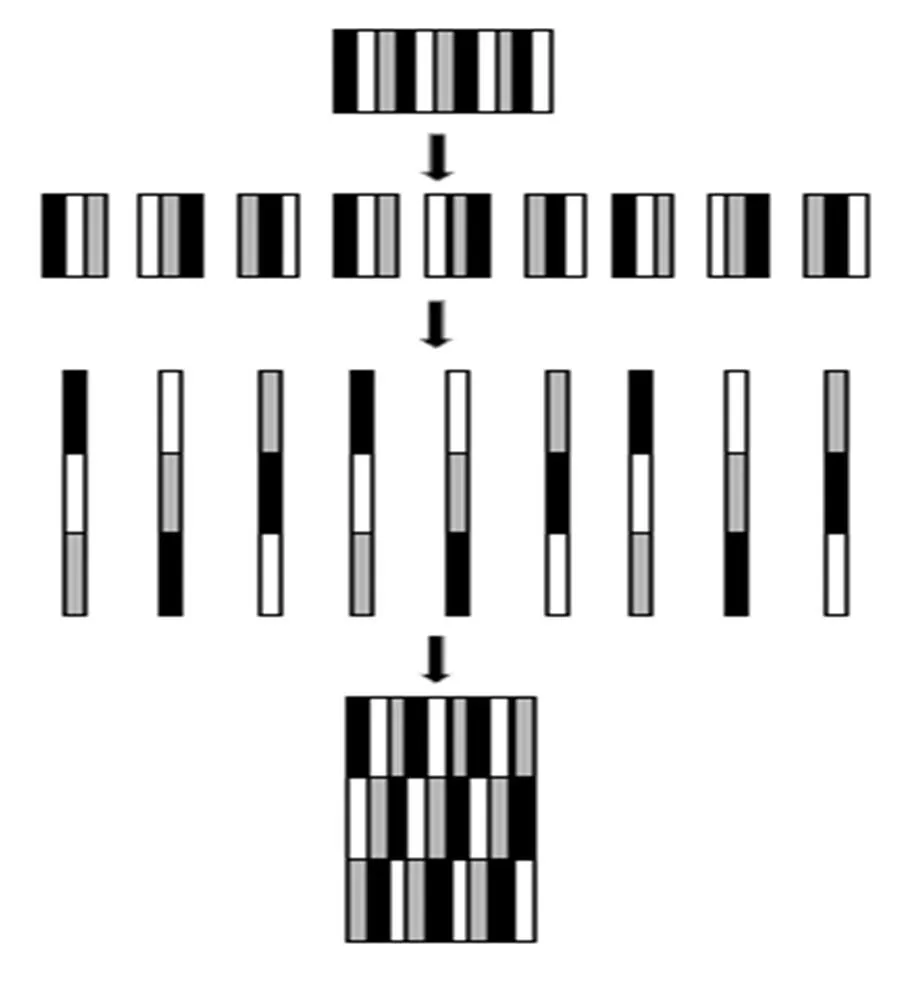
图1 基于非负矩阵分解的递归稀疏表示的心肺音分离方法的构造字典示意图
3.2 稀疏表示

可转化为二次规划问题求解:
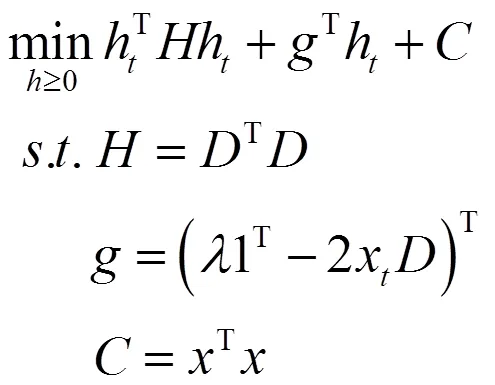
3.3 重构心肺音
时频掩码是基于心脏和呼吸声信号稀疏的假 设[13],在一个小时频区域只有一个源信号占主导地位。

应用时频掩模和混合信号的时频谱以恢复源成分:

再利用逆短时傅里叶变换(inverse short-time Fourier transform, ISTFT)将恢复的源成分转换成时域信号。
4 实验
4.1 实验设置
为验证本文提出的基于NMF的递归稀疏表示的心肺音分离方法的有效性,将该方法在一个自构的心肺音数据集进行测试。测试数据集来源于公开的数据集[14-21],包含112条干净的心音信号,其中正常21条,异常91条;36条干净的肺音信号,其中正常10条,异常26条。由于在不同公开数据集中筛选出的信号具有不同的信号长度和采样频率,本文将信号截取为10 s,降采样至2 kHz采样频率。本文仿真实验以干净的心音和肺音信号按1:1能量比线性混合成的心肺音混合信号为输入信号,通过计算分离得到的心音和肺音信号来评估心肺音分离性能。越高,表示心肺音分离性能越好。
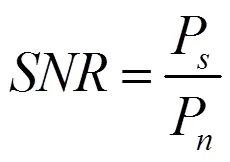
实验中,STFT采用窗长为128个采样点的汉宁窗,窗口的移动步长为32个采样点,傅里叶变换长度为128。

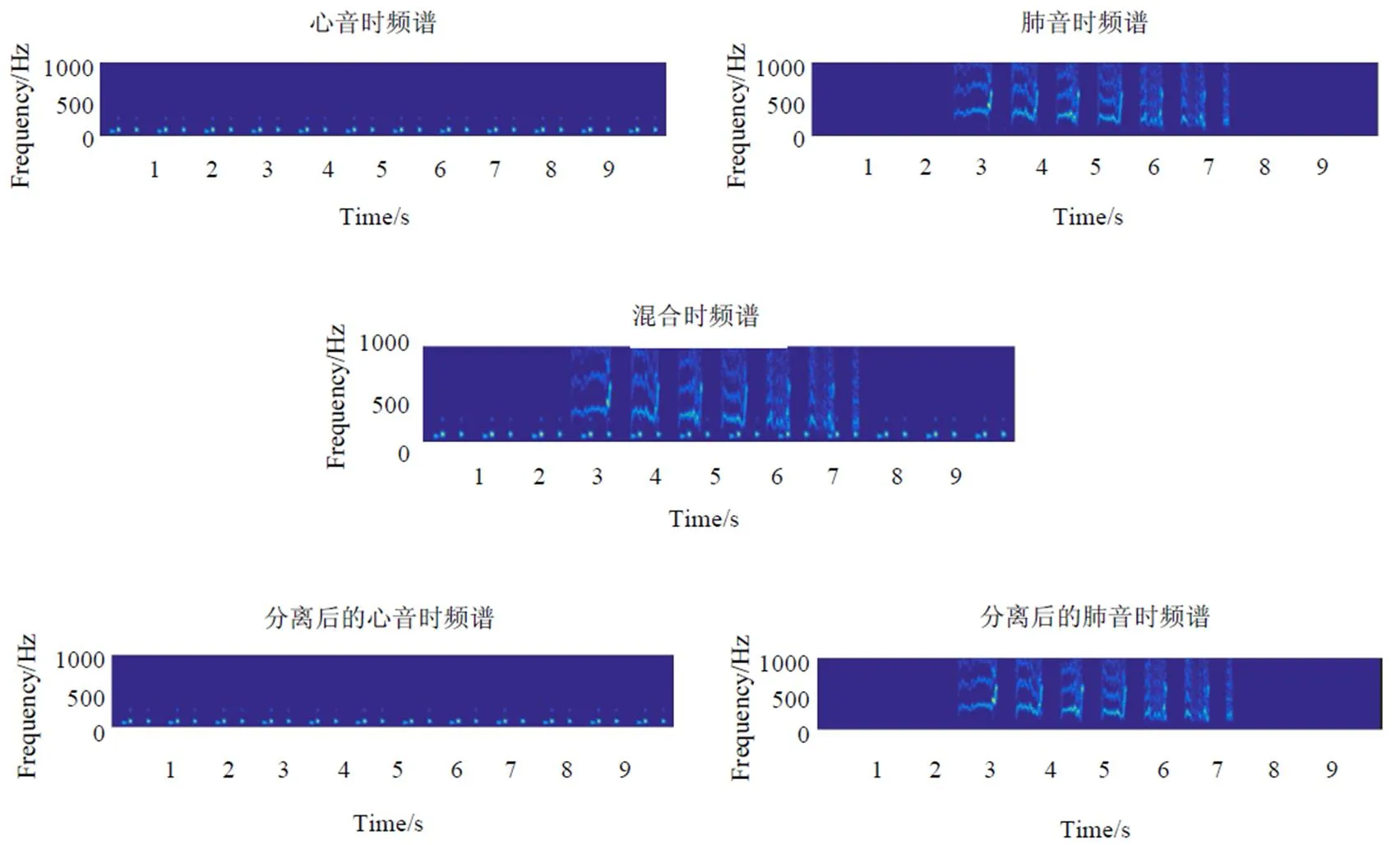
图2 心音、肺音和心肺音混合信号时频谱
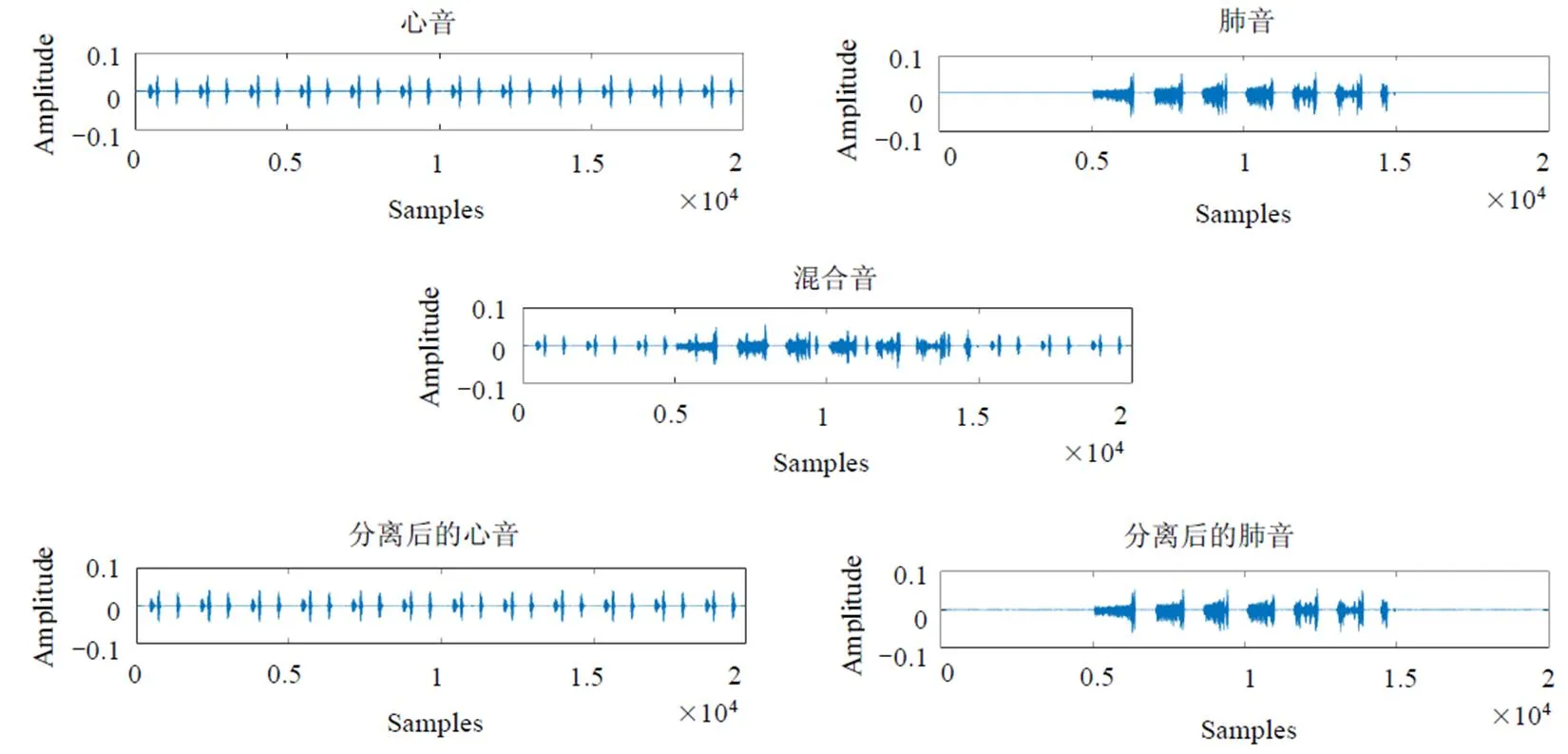
图3 干净心音、干净肺音、混合心肺音和分离后的心音、肺音时域图
4.2 实验结果和分析
表1比较了带通滤波、监督NMF、基于NMF的稀疏表示和基于NMF的递归稀疏表示的心肺音分离性能。与带通滤波、监督NMF和基于NMF的稀疏表示相比,基于NMF的递归稀疏表示方法分离出来的心音信噪比提高了4.09 dB,0.58 dB和0.2 dB,肺音信噪比提高了4.01 dB,0.52 dB 和0.15 dB。表明基于NMF的递归稀疏表示的心肺音分离方法具有更优的心肺音分离性能。

表1 实验结果对比
5 结语
针对心肺音的时序结构特性,本文提出一种基于NMF的递归稀疏表示的心肺音分离方法。在公开心肺音数据集上的仿真结果表明:相较于带通滤波、监督NMF和基于NMF的稀疏表示,基于NMF的递归稀疏表示取得更优的分离效果。
[1] “World Health Statistics 2018: Monitoring health for the SDGs, sustainable development goals,” World Health Organization Tech.Rep.,2018[DB/OL].Available:http://www.who.int/gho/publications/world_health_statistics/2018/en/.
[2] Shi W Y , Mays J , Chiao J C . Wireless stethoscope for recording heart and lung sound[C]// 2016 IEEE Topical Conference on Biomedical Wireless Technologies, Networks, & Sensing Systems, 2016.
[3] Leng S, Tan R S, Chai K T, et al. The electronic stethoscope[J]. BioMedical Engineering OnLine, 2015, 14(1):66.
[4] Gavriely N, Palti Y, Alroy G. Spectral characteristics of normal breath sounds[J]. Journal of Applied Physiology, 1981,50(2): 307–314.
[5] Sathesh K, Muniraj N J R. Real time heart and lung sound separation using adaptive line enhancer with NLMS[J]. Journal of Theoretical and Applied Information Technology, 2014, 65(2):559–564.
[6] Gradolewski D , Redlarski G .Wavelet-based denoising method for real phonocardiography signal recorded by mobile devices in noisy environment[J]. Computers in Biology and Medicine, 2014, 52:119-129.
[7] Lee D D, Seung H S. Learning the parts of objects by non-negative matrix factorization[J]. Nature, 1999, 401(6755):788-791.
[8] Shah G, Koch P, Papadias C B. On the blind recovery of cardiac and respiratory sounds[J]. IEEE Journal of Biomedical and Health Informatics, 2015,19(1):151-157.
[9] Xu L , Yang Z , Shao X . Dictionary design in subspace model for speaker identification[J]. International Journal of Speech Technology, 2015, 18(2):177-186.
[10] Zhen L , Peng D , Yi Z , et al. Underdetermined Blind Source Separation Using Sparse Coding[J]. IEEE Transactions on Neural Networks and Learning Systems, 2017, 28(12):3102-3108.
[11] Shapoori S , Sanei S , Wang W . Blind Source Separation of Medial Temporal Discharges via Partial Dictionary Learning[C]// IEEE International Workshop on Machine Learning for Signal Processing. IEEE, 2015.
[12] Chen P Y, Selesnick I W. Translation-invariant shrinkage/ thresholding of group sparse signals[J]. Signal Processing, 2014, 94:476-489.
[13] Shah G , Papadias C . Separation of cardiorespiratory sounds using time-frequency masking and sparsity[C]// International Conference on Digital Signal Processing. IEEE, 2013.
[14] Bentley P, Nordehn G, Coimbra M, et al. Classifying Heart Sounds Challenge[DB/OL]. (2011-11-01) [2019-01-26]. http://www.peterjbentley.com/heartchallenge.
[15] PhysioNet. Classification of normal/abnormal heart sound recordings: the physionet/computing in cardiology challenge 2016 (Classification of Heart Sound Recordings - The PhysioNet Computing in Cardiology Challenge 2016) [DB/OL]. (2018-08-13) [2019-01-26]. https://physionet.org/ challenge/2016/.
[16] Welch Allyn. Student clinical learning[DB/OL]. https://www. welchallyn.com/content/welchallyn/americas/en/students.html.
[17] Easy Auscultation. Heart and lung sounds reference guide[DB/OL]. (2019-01-26) [2019-01-26]. https://www. easyauscultation.com/heart-sounds.
[18] Open Michigan. Heart Sound and Murmur Library[DB/OL]. (2015-04-14) [2019-01-26]. https://open.umich.edu/find/ open-educational-resources/medical/heart-sound-murmur-library.
[19] East Tennessee State University. Pulmonary Breath Sounds[DB/OL]. (2002-11-25) [2019-01-26]. http://faculty. etsu.edu/arnall/www/public_html/heartlung/breathsounds/contents.html.
[20] Medical Training and Simulation LLC. Breath sounds reference guide[DB/OL]. (2019-01-26) [2019-01-26]. https://www.practicalclinicalskills.com/breath-sounds-reference-guide.
[21] PixSoft. The R.A.L.E. Repository[DB/OL]. (2019-01-26) [2019-01-26]. http://www.rale.ca.
Cardiopulmonary Sound Separation Method Based on Recursive Sparse Representation of Non-Negative Matrix Factorization
Zou Zhencheng Liu Siyuan
(Guangdong University of Technology)
In order to address the time-series structure characteristics of cardiopulmonary sound, a method of heart-lung sound separation based on recursive sparse representation of non-negative matrix factorization is proposed. The recursive feature cardiopulmonary dictionary which can effectively describe cardiopulmonary sound is constructed by non-negative matrix factorization. Based on this dictionary, we get a sparse representation of heart sounds and lung sounds to achieve separation of heart and lung sounds. The experimental results show that the cardiopulmonary separation method is designed in this paper achieves a cardiopulmonary separation method superior to the sparse representation based on non-negative matrix factorization, and supervises the cardiopulmonary separation and band pass filtering effects of the non-negative matrix factorization method.
Cardiopulmonary Separation; Non-Negative Matrix Factorization; Recursion; Sparse Representation
邹振城,男,1994年生,硕士研究生,主要研究方向:模式识别,机器学习,生物信号处理。E-mail: walnmm@126.com

